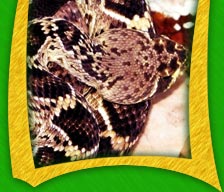|

SCARLET KING SNAKE
Photo by: Dawson
|
GUESS WHO
Noted for its bold red, yellow and black colored bands, Florida’s
Coral Snake is a shy reclusive reptile that prefers to hide underground,
beneath leaf-litter and other debris. These secretive animals are
small, and on average only grow to be 24 inches in length; but don’t
let its small size fool you! A Coral Snake’s neurotoxin is
strong enough to kill an adult human.
Be careful, looks can be deadly!
Due to its striking resemblance, people commonly confuse the non-venomous
Scarlet Kingsnake and the Milk Snake with their deadly look-alike
-- the Coral Snake. In both the non-venomous species, the red and
yellow colored bands never touch; but when this coloration is side
by side, it’s a sure sign to stay away. If you can’t
remember the color sequence, try memorizing this, “Red touches
yellow, kill a fellow. Red touches black, you’re O.K. Jack!”
TOXINS TO LIVE
Through research, scientists from
around the world are discovering venomous snakes may have the key
to combat cardiovascular disorders, neuropathic disorders, and even
cancer. Drugs that contain chemical compounds derived from poisonous
snakes in Brazil are being used to treat people suffering from high
blood pressure. In addition, venom from East Africa’s Green
Mamba is being tested for potential aid in Alzheimer’s disease,
epilepsy and Parkinson’s
diseases. A study on the Eastern Diamondback Rattlesnake reveals
its toxins may even retard the growth of cancerous tumors.
PYTHON INVADERS
The Florida Everglades are under attack by an invasion of pythons.
Over the years, Burmese or Asian pythons have shown up in and around
these wetlands as a result of owners who no longer want to care for
such massive reptiles or simply do not have the room to house them.
With abundant food and space, these constrictors have quickly grown
in numbers and size. So much so, there have been reports of pythons
preying on large alligators.
A vast array of the endangered species
that live within the Florida Everglades are further being threatened
by these foreign snakes. Their presence has altered this delicate
ecosystem, and now wildlife officials are looking for ways to prevent
and control this epidemic.
Resources for this article have been provided
by Wikipedia, Florida
Wildlife Control, the Everglades
Burmese Python Project and
the Florida
Fish and Wildlife Conservation Commission.
|






